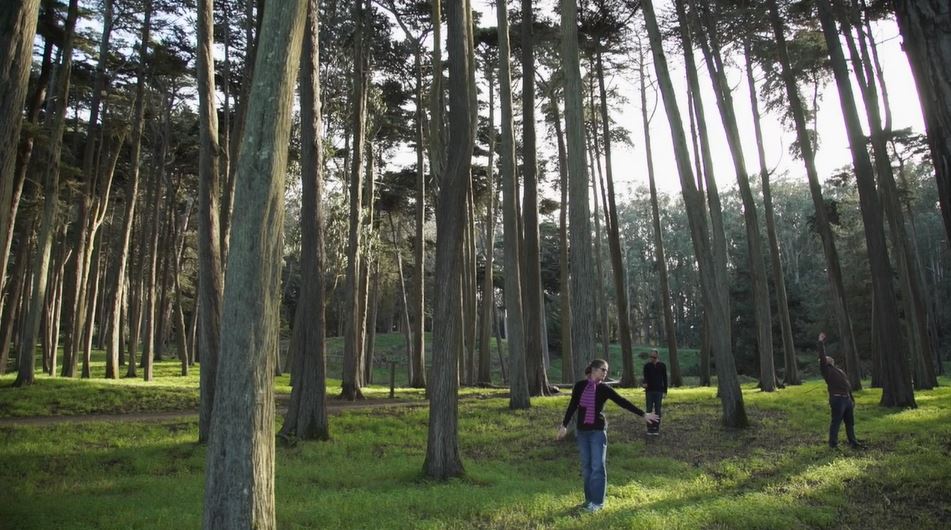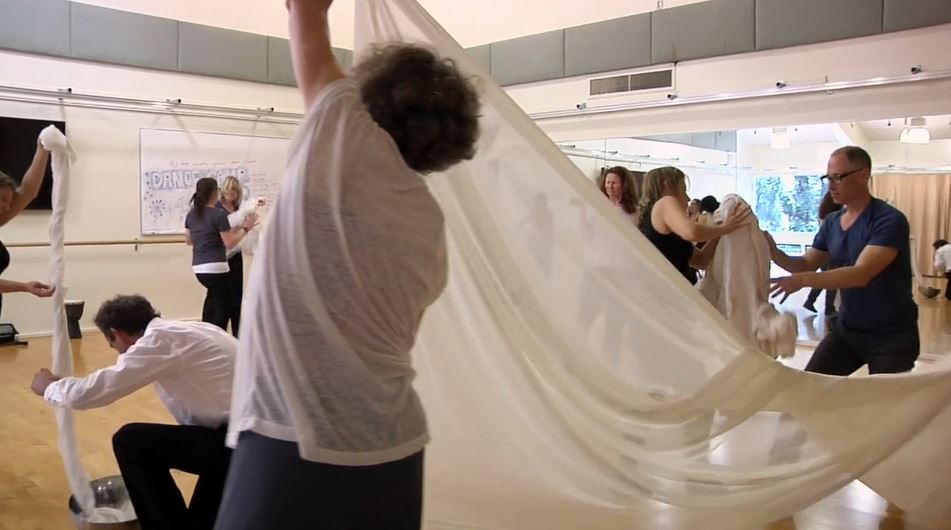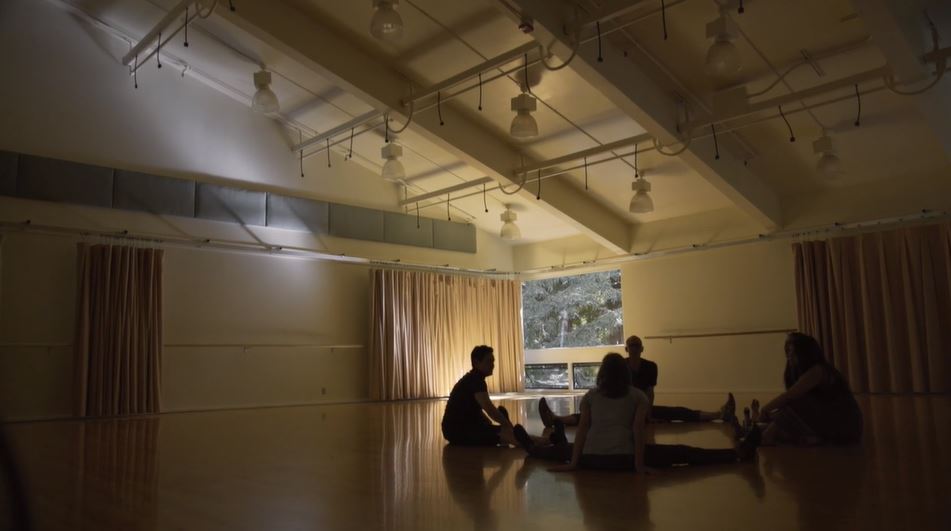Between Memory and Muscle
An Interview with Mary Trunk
Mary Trunk is involved in Muscle Memory, an interactive video project examining age and dance. The premise of her project is a reunion of sorts with peers from her college dance department, now in their 50s. Where has dance taken them? What role has it played in their life? And how has their dance continued?
What was the genesis of the Muscle Memory project?
Muscle Memory is a project that has been on my mind for many years. The desire to explore the core of my creative experiences ruminated in my brain for a very long time.
I started college at UCSC as a painter and visual artist but I had always loved dance. I was a late comer to it, and didn’t think it was something I had real talent for. My drawing skills seemed much more developed. What I found out was that it really didn’t matter what level my experience was. If dance trumped drawing, then I should go for it.
After seeing a student dance performance while eating my dinner in the dorm dining hall I thought, “Can I do that?” I auditioned for the dance department and I’ll always remember when the head of the department came behind me as I was warming up and said, “Where have you been?” I laugh about that; I have great feet and I think that’s why she said it. I’m not flexible and my body does not fit the dancer stereotype.
That was the beginning of my dance life. I abandoned all my art classes and fully immersed myself in dance and performance. I loved every very minute of it, even when I was absolutely terrified to perform or show my work. I look back on that time as the most creatively inspiring part of my life. In many ways, it gave me the permission to be creative, to find my own voice and to take risks in ways I never would have outside of that environment. That period and those experiences have stayed with me even as I became a filmmaker.
So that’s the long way of saying that I have had this strong feeling and need to reflect on that time, to see if others felt like I did, to examine why that time sparked such a drive in myself and possibly others. As the head of the department, Ruth Solomon, said to me in her interview, “It was the golden age of the dance department.” And it seemed that way to me.
As I entered my 50s, having just completed a documentary film about mothers who are also artists (www.maandpafilms.com/lostinliving), I realized it was time to investigate my former dance life. I wanted to reignite that passion for dance. I wanted to talk to my former dance partners and friends about what dance meant to them, if they are still dancing and how dance shaped who they are now.
How is the project organized?
I reached out to people I danced with in college. Specifically, people who had inspired me with their choreography, their performances and their commitment to a creative life. Some of these people I had stayed in contact with over the years while others I had not. Everyone I approached was enthusiastic and game for participating.
Many were nervous about the idea of actually dancing again. I convinced them that the movements would be gestural and open to their interpretation. I wanted the project to be a hybrid of sorts: part dance video, part documentary and part interactive web site. Since everyone lives in different parts of the world, I sent them written choreography and instructions to create other types of work to include in the project. This work includes sound, photos, archival footage, their own videos, text, etc. The work they send me will be compiled into a personal webpage for each participant so viewers can enter their world and their stories from different vantage points. A composer friend, also from college, will organize the sounds to create individual sound scores for each individual as well as for the entire project.
I have also visited some of the participants to film them dancing the choreography. I wanted them in their own environments, wearing their own clothes and moving in ways that felt most comfortable to them. We chose interior spaces and exterior landscapes that each person felt drawn to or had emotional feelings for. So far, I’ve filmed in New York, San Francisco and Santa Cruz. I hope to get to Toronto and Sweden at some point. This footage will be integrated into the documentary footage as well as part of a dance video. I want to use their movements to tell my own story through dance and that’s partly why I’ve decided to be in the project. The documentary element will include interviews with the participants, dance video footage and archival material.
Last summer I contacted the alumni foundation of UCSC to see if they would provide special funds for all of us to meet on campus to film and create new work. They helped us obtain the use of our former dance studio for a full four days of choreographing and filming. Some of that footage is in the first video excerpt, Muscle Memory #1. It was a fantastic experience to surrender once again to that kind of work. Dancing with others and creating movements brought back all those incredible feelings of being in the space of creative flow. No one cared what anyone looked like, that we weren’t as limber as we used to be. We just did it and it felt right.
Where does the project stand now?
The current video will be used to help raise funds to complete the project. It is definitely an excerpt of something I hope will be more comprehensive and multi-dimensional. I have accumulated a lot of footage already and I have plans to do more over the summer. I’m hoping to complete the project by summer of 2017. Either way I will continue to make sections to share.
What were some surprises you didn’t expect while making the project?
I was happy to know that people were so willing to dance again even if they hadn’t in a long time. For some it seemed like I was giving them a great gift, and that was incredibly gratifying.
The one thing that I might call a surprise is that some of the participants didn’t have the same experience I did in college. I expected that, of course, but I think my assumption was that everyone loved that time period. Not everyone did. Which is definitely good conflict for the project. Overall, though, I chose people who saw dance as a huge part of their lives and in some ways still do.
What do you hope to convey to others through the Muscle Memory project?
I hope that others can experience the delight and joy in expressing oneself at any point in one’s life. Why is it that a person who is in their 50s (or older) is sometimes considered less valuable or less expressive than a younger person? Especially in the dance world…
I also want to show how people remain creative in all kinds of ways even if they have stopped dancing. How life can push you in a direction you didn’t expect and how you make it work, how you deal with regret, pain, illness, family life, jobs, children and identity. Do we have the capacity to stay creative and be resilient and how do we do that? I hope Muscle Memory can show that.
Why is a dialogue on aging in dance important?
We as a culture are seriously conditioned to see youth as having all the value. It is ironic that our demographic of older people is growing so much. It’s obviously time to change the paradigm and see the beauty and worth in aging. Possibly that’s why I’m making this project – to come to terms with my own bias about aging. It shocks me that I sometimes feel embarrassed that I’m aging. But that doesn’t mean I can’t still dance and make work, and I plan on doing that.
I think video is a wonderful way to reframe dance in a different art form and show all ages moving. Just by way of composition, close-ups, camera movement, etc., I can focus on people in ways that will bring viewers closer and experience dance as something for all ages.



